Editorial
It's been a quiet month here, with Ruthie overseas—just me and the cats. Regarding the loss of my digital camera in the break-in mentioned last month, fearing the worst from the insurance company, I went looking on eBay for a replacement to my old circa 1999 Nikon Coolpix 950 and found a quite inexpensive Coolpix 4500 (circa 2002) in as new condition. After buying it, the insurance company decided the equivalent to my twelve year old Nikon was the new Coolpix P510. Guess what? The P510 is just about infinitely better than the 4500, which is significantly better than the 950! I guess Moore's Law applies to digital cameras too. My only quibble with it is that the older cameras have a more solid "feel" than the P510, which is light and somehow feels "cheap". I think I paid about a grand for the 950 back in the dim distant past. The P510 has a street price here of about half that and even takes movies.
My lost laptop got replaced too with a new 15" Macbook Pro. I had to pay for the extended warranty myself though as the insurance company considered that to be "software", and so, not covered. Luckily I run a good household network, so no data was lost and the rebuild to get all my applications and stuff on the new laptop was completed in about half a day. Try that on a Windows box! So far, I've not received the email advising me of the stolen one's location, so either the felon knows the risk of connecting it to the Internet, or doesn't know how.
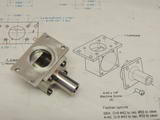
I've made a little progress on building the Cicada, and validating the plans in the process. The main thing I'm looking for is missing dimensions. My plan philosophy—such as it is—says that a builder should not have to perform math in order to machine a part. So far, I've added just one new dimension to the crankcase to save other builders the challenge of subtracting 0.350" from 1.000". The crankcase and front bearing are all done (two crankcases, actually), but I don't seem to work as fast, nor as efficiently as I once did.
However, The Library has been totally tidied and reorganized, this being one of the tasks Ruthie left me with when she toddled off to the UK. Most of her plants are still alive too, so I guess we can say the hosing task was almost successful too. Anyway, she's back as this morning (September 30), having missed her flight only once. I tracked her return using a service called "Flight Radar 24", which is available as a web service, or as an app on your iMumble device. This is Yet Another Absolutely Amazing piece of applied technology (YAAA). I think we are now seeing stuff that not even science fiction authors of the near past ever imagined.
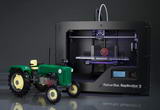
I'm also pleased to report that I'm still successfully resisting the urge to build a RepRap. Besides, there are now "consumer" grade 3D printers around, such as the MakerBot Replicator 2 which prints in 100 micron layers—that's 0.10mm, or 0.004". That is seriously getting into the ballpark. What I'd use it for is still hazy, but custom spinners for three and four blade props has been suggested, as have pilot figures for models (resist, resist, resist...)
We don't have quite as many news items this month as we did last, but some are longer, and hopefully more thought provoking than usual. First though, we have a piece of sad news to pass on...
Vale, Ivan Rogstadius (1915-2012)
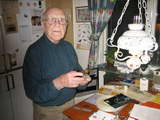
We were all saddened to hear that Ivan Rogstadius, a Swedish pioneer designer and builder of compression ignition engines for model aircraft, passed away on September 22, 2012. Ivan was an engineer, not an aeromodeler, but he had a strong interest in how the first "diesel" engines worked and pioneered a design which allowed others to duplicate it. In 2009, we were fortunate to make contact with Lars Gustafsson through Adrian Duncan. Lars took it upon himself to locate and visit with Ivan and discuss many topics, as retold oun our Ivan Rogstadius Tribute page. Lars maintained the contact and visited with Ivan only a few weeks ago, discussing over coffee, the things Ivan intended to do in the coming months. While we are saddened, we are happy that Ivan was able to share his early recollections with us and you through Lars, and offer our sincere condolences to Ivan's family.
Bantam Twin
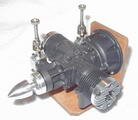
A little while ago, we added a short biography of Ben Shereshaw to our growing parade of people who have contributed in some way to the world of model engines, model engineering, and note-worthy odd-balls. The article in question, taken from American Modeler of January-February, 1966, used the title Bantam Ben, alliterating the B's to link Ben with the type of engine he is most known for. It also mentioned a twin, which was at that time, a new design to be manufactured and sold by, according to the article, the "Bonner Tool & Mfg Co" (sic). Well, this month, we have another Janson review for you on the genesis and history of the Bantam .60 Twin. While doing all the OCR and magazine research work required to put this together, I noticed that the 1966 American Modeler got the name of the company slightly skewed; it's actually the "Bonner Mfg & Tool Co". Earth-shattering information I know, but there you go...
Model Engine Builder Goes Fully Digital
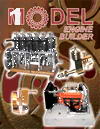
Back in March, 2005, Mike and Toni Rehmus of Elmwood Publishing Inc, launched Model Engine Builder Magazine and I feel a bit proud that Volume 1, Issue 1 contained full plans and construction details for my Mk I Mills 1.3 Replica. Since then, a total of twenty-seven issues have rolled out to model engine builders all over the world. Starting with Issue #28, MEB will go fully digital, meaning subscribers will be able to access it on-line, and only on-line. This will be in the form of a pdf document, allowing it to be read locally on your computer, printed, loaded into iTunes for transfer to an iPad, or placed onto your Kindle, or Android-based tablet.
This is a mixed blessing. As I'm sure everyone knows, the US economy is not all that strong these days, as evidenced by the fact that the humble Australian dollar—once called the "south pacific paso" by a past Treasurer of the country—has been trading at above parity with the US dollar for more than a year. Faced with rising costs, taxes, fees, charges, and frustration, Mike and Toni have taken the hard path which will keep MEB flowing, rather than simply shutting down.
Existing subscribers will receive a two for one bonus on their current subscriptions, and new subscribers will pay a mere US$24 for four issues, or US$44 for eight issues, regardless of global location. Elmwood has obviously though long and hard about this and present this list of positives on the new format:
- The magazine will get to subscribers sooner.
- Magazine content is not limited by the constraints of paper, so can include additional pictures, video, 3D models, etc.
- The magazine will be reasonably immune to increased publication and mailing costs.
- Magazine pages including drawings will shift to 8.25" X 11" (210mm x 279mm) size which will print on letter size paper in either the A size of North America or the A4 size of most of the rest of the world. A 3/4" (19mm) strip on the left side of the page will be left for a 3-hole punch if you want to put pages in a binder.
- Digital back issues will replace those issues that are out of print (issues 3, 4, 6, 8, 9, 10 & 21) will be $6 no matter where you are in the world.
As I mentioned in last month's Editorial, I now far prefer to take my magazine subscriptions on-line, so to me, this is a very positive step. At the same time, I know others don't like reading on a screen, or even a tablet for that matter, and there's the issue of persistence. A lot of the material we present on this web site is predicated on a vast collection of old magazines, and even though many are turning yellow and falling apart, at least they exist in a physical form which, as many are older than the researcher is question, has allowed them to be tracked down and purchased at great cost. You don't quite get this longevity with ones and zeros spat out of the ether. Then again, what will happen to all my yellowed paper when I go is another matter, but let's not talk about that right now!
So overall, I sincerely applaud Mike and Toni's brave and honorable decision to keep the faith with their readers and continue in a modern format. I was almost tempted to offer to write the iPad app for them, but luckily sanity prevailed  ! Besides, I should do it for MEN readers first.
! Besides, I should do it for MEN readers first.
Chenery, by Stone
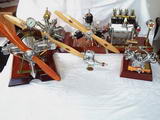
Motor Boy, Les Stone, has completed and test run his Anzani "Y" three cylinder radial which we mentioned in the August issue. This photo shows Les' complete Chenery Collection. Left to right, and front to back, they are: The Aeronca, the side-valve, the V-Twin, the Gnome rotary, the Anzani "Y" radial, and the DH Gypsy. Les has not simply (simply!?) built the engine as detailed on the plans. With the exception of the single cylinder side-valve four-stroke, all sit on highly polished display stands with engraved plaques. Each stand supports a beautifully executed array of accessories, such as fuel and oil tanks, oil pressure gauges, etc. All also exhibit Les' signature "engine room" polish and sheen. For more pictures of the completed Anzani, including the all-important "running" shot, visit the Les Stone Tribute page. Scroll to the bottom for the latest Anzani pictures. All of us agree that Les has pulled out all the stops on this one—a magnificent effort.
Completing the Atom Minor Mk III
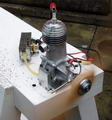
We've come to the finale of Jan Huning's build of the Westbury Atom Minor Mk III, with the Piston, the Connecting Rod, and Final Assembly. Jan has run his engine extensively and observed that while running, the crankcase was hot—too hot to touch, in fact. Reasoning that perhaps exhaust gas was entering the transfer passage, Jan machined 0.010" off the top of the piston on the exhaust side of the baffle. This has the effect of increasing the exhaust duration without changing the transfer timing, thus increasing blow-down. Jan reports that the modification made no difference at all!
My first reaction on hearing this was to suggest that rather than increasing the exhaust duration, it may have been better to decrease both transfer and exhaust so that the combustion gas has a longer period in which to expand, resulting in a cooler exhaust and possibly allowing it to do a bit more piston pushing before being let out the gate. That however would require use of the putting-on tool, rather than the taking-off tool, and few of us own such a device. On further reflection, I decided we really needed to find out just what the timing was. ETW designed the Atom with 1/16" of desaxé, and since the MEN Timing calculators don't currently take this into consideration, a bit of quick 2D CAD work was the order of the day.
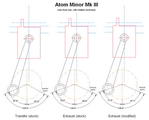
Here are the results, with a bit of color to hopefully make things clearer. I've used a conrod length of 1.702" because, as noted on the Atom Minor Mk III page, the plan and booklet dimension is short by 0.03", or so. All other dimensions are "stock". I've also drawn the conrod as a profile, although the accurate representation is a circle, centered on the gudgeon pin, with a radius equal to the conrod between centers length, but that looks ugly. So we see that the (rounded) "stock" transfer is 129°, with an exhaust of 136°. That gives a blow-down of 7° which is a bit low, but not awful.
Even if you don't give a rats' about the Atom Minor Mk III and its timing, take a moment to see the effect of the desaxé. The view is from the rear of the engine, retaining the orientation of the drawing of the crankcase in the ETW book, so rotation is clockwise. The offset of the cylinder has introduced roughly 5° of skew into the exhaust and transfer symmetry. This skew results in a faster power stroke with lower side-thrust and friction.
On the right, we see the result of Jan's experiment with the exhaust side of the piston lowered 0.010". This increases the exhaust duration to 139°, raising blow-down to 10°, which is closer to what long years of development have decided is about right for a "sport" class of engine. The exhaust and transfer durations appear to be rather on the wide side of what we might expect, but remember the desaxé! If this engine's timing were symmetrical from the opening points, the "stock" exhaust would be 132°, with a transfer duration of 124°. This is still at the high end, but by no means excessive.
If we merely looked at the "stock" durations, we may conclude that both could well be decreased by 10-12°. Taking the desaxé into consideration, a reduction of the start of exhaust and transfer to say 64° BBDC and 55° BBDC respectively might allow for more gas expansion, and a cooler, quieter exhaust. This could be accomplished a number of ways, but each has knock-on effects and requires considerable work, all of which may give no appreciable return.
However, top marks to Jan for making the observation about the running temperature, forming a theory, and conducting an experiment to investigate his theory, even if the results have been inconclusive. If some brave future builder of this engine wants to try reducing the exhaust and transfer durations, please drop us an email.
New Books and Magazines This Month

A most unexpected and welcome surprise arrived in the mail box this past month in the form of a package all the way from Canada containing the latest iteration of Frank and Vicki Anderson's Blue Book for (mostly) American model engines produced between 1911 and 2012. Ok, now re-read the last part of the previous sentence. Has it penetrated yet? "1911-2012"? That's ONE HUNDRED AND ONE YEARS (or 100, if you prefer to count the gaps in the fence rather than the palings).
According to the Model Engine News Book Review Index, we've previously reviewed the Fourth Edition, and the Fifth Edition of the Blue Book, so rather than repeat (and possibly contradict myself), I'll simply mention the changes from the previous edition [aside: strange, that's what I said last time, too! end of aside]. Obviously, coverage has been extended to include the years 2010 through 2012. I could go on and précis what the Andersons have to say in their Foreword to the new edition, but taking the stance that it's better to quote than plagiarize, here's the essentials from the introduction:
The most important item in this 6th Edition is a drop in most of the selling and sold prices of our American Model Airplane Engines !
We pulled out all of the Model Engine Collector Swap Sheets over the past 3+ years and noted a drop in Asking Prices, primarily by repeat members/sellers.
We than sourced Auction/Sold Prices for eBay and noted they followed MECA Swap Sheet Asking Prices; "Down"! Not a lot, but certainly lower!
One of the reasons for lower MECA Prices seems to be the demise of a number of elderly collectors... and their collections now being sold off by family members or other collectors in both MECA and on eBay.
The majority of sales indicated to us that many of the 'sellers' had no prices provided on paper by the 'departed' ... and in a number of cases seemed to be unaware of the reduced value of engines for missing parts such as needle valves, timers, plugs, oversize mounting holes, broken lugs and missing cylinder and head fins, etc.
The current poor economy also seems to have created a little less purchasing power of Americans and certainly of those overseas.
This 6th edition should be used to provide most Collectors with a "paper trail" for their family on prices or an approximate valuation of their collection.
Model Engine Books seem to be on the increase; Tim Dannels & Dan Sitters 'Cox's'; Woody Bartelt's Repro of 'Model Engine Reviews'; Favorite Engines in Color, Volumes I & II, by Dale Jordan; Dennymites, Drones & More by James Dunkin etc. ... plus some new foreign books! Acquire these inexpensive books for your enjoyment.
This will probably be the last complete book on engines from us because only the prices can change over the next few years ... make sure you identify yours in your collection.
We've enhanced all the pictures and added more (i.e. Queen Bee's) plus more care with the text ... hope you like our efforts!
Frank & Viki Anderson
Frank and Vicki made some very sound observations about the state of the nation there, and I completely agree. In fact, the only issue I can find with the 6th Edition, is that like the 5th, it includes of all of the RJL engine range. I have no issue, nor argument with the fact that RJL has the rights to remanufacture a large number of classics, both American (the Johnson range, for instance), and "foreigners" like the Marown Engineering (ME) range, and the Allen Mercury range. But they haven't, and probably won't, and until such times as they do, their inclusion is a bit misleading—to me at least. It just causes a page of zero-zero information for MECA and eBay prices, when data does exist on the original items, but as transactions would occur mostly on the UK eBay site, tracking them would be a nightmare for the Andersons and nobody could fault them from not doing so. On the positive side, the Blue Book listings do record the current ownership of the rights and tooling, which is interesting of itself.
So, as previously, Anderson's Blue Book 1911 to 2012 is a mighty effort and invaluable to collectors and researchers of American Model engines. Irrespective of my little philosophical rant about the inclusion of the RJL collection, I totally recommend this new volume and add my thanks to the Andersons for all of the effort they have lavished on this publication over the years. It ranks a solid four and half stars  .
.
Engine Of The Month: Comet

Prepare to be surprised. I'll bet you thought the Comet in question was the 1941 spark ignition one produced by the Comet Model Airplane & Supply Company of Chicago, IL, the people who also made those great stick and tissue rubber scale models for years and years. Well, it turns out there is another Comet (why is that Star Wars theme playing in the background), this one from the British Isles. It's place in the sun was brief, but it's a rather nice looking old thing and Adrian Duncan will explain all about it on the new Comet 0.4cc Diesel page.
Tech Tip of the Month
I'd planned something else entirely for this month's Tech Tip, but before we get to that, a question came up regarding the material used for the cylinder of a well known British glow engine. It was well known that the rather thin fins of the engine were prone to breakage, a common problem with cast iron cylinder fins, but noted authorities of yester-year had insisted it was made from steel, which will usually bend rather than fracture. My first thought was to apply the spark test, even if it is a rather destructive process. I put this suggestion forward to any of the group who had a severely damaged cylinder they would not mind touching to the grind-stone and was a bit surprised when some asked what the test entailed. Good question, and if you don't ask, you'll never know, so under the assumption that this venerable process may be in danger of becoming lost, here it is.

The diagram shown here is taken from Shop Theory, an old but useful McGraw-Hill publication which first appeared in 1934 (my copy is the 1955 Fourth Edition). It shows how different metals, when touched to a grind-stone, produce different patterns of sparks, in different colors. I've used this in the past when I suspected some stainless steel rod had crept into the drill rod bin (or "silver steel", if you prefer the Empire term). Drill rod is a high carbon steel and produces a characteristic spark pattern that even a beginner can easily identify.
Another suggestion on our mystery cylinder material was to mount one up in the lathe and try a very delicate skim on the tip of a fin. Cast iron would give fine sand-like particles, while steel would produce your typical swarf, or just make the HSS cutter turn blue if it was case hardened. In the final analysis, our British expert, Eric Offen, simply tried drilling a hole in a fin and proved it was steel, case-hardened so hard and deep that the fins will break rather than bend. As to what the engine in question was, for that you are going to have to wait... 
-oOo-
Now for what I'd first though of, and we'll see its belated application in the next news item. Unless something is seriously amiss, as the piston reciprocates and the crankpin circulates, the connecting rod follows a complicated but tightly constrained path. Obviously it is going to swing from side to side and the crankcase must provide sufficient room for it to do so, or the dang thing ain't gonna turn over, nohow! I know engine builders who have milled the conrod clearance into their crankcase by guess and good will, and will admit to doing so myself before I knew better. So the question becomes, at what point in the rotation of the crankshaft does the conrod reach its maximum side-ways excursion?

The answer is quite simple: it's the point at which the triangle formed by joining the axis of crankshaft, crankpin, and wristpin is a right angle triangle with the 90° angle between by the sides you get by joining the axis points of crankshaft to crankpin, and the crankpin to wristpin. I don't know why I bothered to even try putting that in words, just look at the picture!
You can draw the situation out easily or paper, or CAD, using Herr Pythagorous' famous theorem about the hippopotamus and the squaw on the other two hides to find height of the wrist pin axis above the crankpin axis when the 'rod is at maximum deflection. Now draw a circle at the path followed by the crankpin axis, and draw a line tangent to this circle which passes through your calculated point in the cylinder axis.
Naturally, this is precisely correct only for engines which have no desaxé, but even then the error is going to be so small that you'll be in the ballpark and close enough for Jazz, or Government Work. Overlay the conrod shape on the line, and draw a line parallel to the side of the conrod such that you have a bit of room to wriggle in, and you have the angle and depth you need to mill away the crankcase channel at. For when I failed to apply this bit of wisdom, read on...
MBI Plan Book Correction/Update
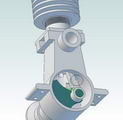
I received one of those irritating emails during the past month—you know, the sort which makes your manifest failings and past transgressions abundantly clear. This one came from our friend and supporter, Steve Huck; the Huck's Cams, and Demon V8 Guy. Steve has been doing a spot of 3D modelling of the good old Gotham Hobby Deezil using the plans in the MBI Plans Book and discovered that as drawn, and as mentioned above, it ain't gonna turn over, nohow. He also spotted the place in a note where I called out a dimension using a fraction in 32nds which should have been 64ths (minor detail)! So sheet 2 of the Deezil plan set has been updated and you can download your copy from the MBI Book page here, regardless of whether you own the book, or not. And upon that note, we retire, hurt, stage left, until next month...
Briefly Noted
This section is intended to alert you to little things that are hard to expand to a full news item, or cunningly wind into the Editorial, but are worthy of note never the less.
- Minor corrections have been made to the Bungay 600, and Hornet pages.
- Two engine reviews have been added to the Giant Engine Review Index: The 1961 Model Aircraft review of the Keil Kraft Cobra (mentioned last month), and the very comprehensive Chinn review of the plastic rocker box Technopower 7-Cylinder Radial which appeared in MAN in March, 1984.
- As if the Deezil crankcase boo-boo was not enough, another reader thanked me for the Allen Engineering AE Engine page, then pointed out that the article suffered from a rather laissez faire approach to spelling. He could not be more wrong. On examination, it became evident that rather than being a bit casual, the quality control on the page was in the negative region! The page has been corrected and revised into the modern MEN format. Any remaining mistakes are still all my own work.
- Ditto the AM35 page, which also gets some new images and hyperlinks to other related pages.
 Vale, Ivan Rogstadius (1915-2012)
Vale, Ivan Rogstadius (1915-2012)
 Bantam Twin
Bantam Twin
 Model Engine Builder Goes Fully Digital
Model Engine Builder Goes Fully Digital
 Chenery, by Stone
Chenery, by Stone
 Completing the Atom Minor Mk III
Completing the Atom Minor Mk III
 MBI Plan Book Correction/Update
MBI Plan Book Correction/Update
 Editorial
Editorial
 New Books and Magazines This Month
New Books and Magazines This Month
 Engine Of The Month: Comet
Engine Of The Month: Comet
 Tech Tip of the Month
Tech Tip of the Month
 Briefly Noted
Briefly Noted
 Standard Stuff
Standard Stuff






 ! Besides, I should do it for MEN readers first.
! Besides, I should do it for MEN readers first.




 .
.



